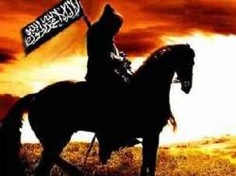
The horse and rider motif is common in Islamic imagery and jihadi visual propaganda. The rider emphasizes the element of human agency in jihad, and is a way to enhance the traditional symbol of a horse and flesh out notions of aggression and the call to jihad. The importance of the horse in both pre-Islamic Arabia and Islamic culture is evidenced by pre-Islamic poetry, hadiths (prophetic traditions or reports) and other genres of literature ascribing horses with the positive qualities of chivalry and bravery in battle. For example, the beginning of the Qur’anic sura 100 talks about “running horses” that appear as galloping through the world toward the final goal, namely, Judgment Day. Horses are also symbolic of the first generation of Muslims and that generation’s successful military campaigns, and thus are often employed to evoke specific Salafi religious sentiments with regard to the military victories of Muhammad and his companions.
The black color of the rider and horse is significant. The black banner is the joint symbol of vengeance and revolt that traces its roots to prophetic times. According to prophetic tradition (hadith), the black flag was the battle flag of the Prophet Muhammad and it was carried into battle by many of his companions. The image of the black flag has been used as a symbol of religious revolt and engagement in battle (i.e., jihad). In the contemporary Islamist movement, the black flag is used to evoke notions of jihad and of reestablishing the Islamic Caliphate.
Another visual element in the image is the clouds in the background. In Islam, clouds are a sign of Allah’s total inscrutability prior to creation. The cloud is also the bearer of rain and therefore bounty (khayr, which is a synonym for rain), and is a sign of good things to come.
 Skip to content
Skip to content
